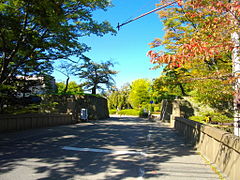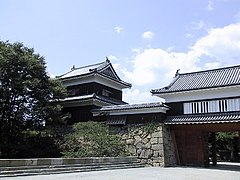Ueda Castle
| Ueda Castle | ||
|---|---|---|
|
Ueda, castle entrance |
||
| Castle type : | Hirajiro (Ebenenburg) | |
| Conservation status: | Partly reconstructed | |
| Place: | Ueda | |
| Geographical location | 36 ° 24 '14.9 " N , 138 ° 14' 39.4" E | |
|
|
||
The Castle Ueda ( Japanese 上田城 , Ueda-jō , more names are Amagafuji-jō ( 尼ヶ淵城 ) and Matsuo-jō ( 松尾城 )) is located in the city of Ueda ( Nagano Prefecture ). In the Edo period , a branch of the Fujii Matsudaira resided there as the Fudai daimyo .
Lords of the castle in the Edo period
history
Ueda Castle was built so well in 1583 by Sanada Masayuki ( 真 田昌幸 ; 1547–1611) that it successfully withstood the two sieges of the Tokugawa in 1585 and 1600.
After winning the battle of Sekigahara , Masayuki was transferred, the Tokugawa had the castle demolished. After the demolition, however, Masyuki's son Nobuyuki ( 信 之 ; 1566–1658) received the area. He built himself a residence, called oyakata ( 御 屋 形 ), on the back of the former San-no-maru ( 三 ノ 丸 ) area. The inner areas, the Hommaru ( 本 丸 ) and the Ni-no-maru ( 二 ノ 丸 ) were then rebuilt by the Sengoku from 1626 onwards.
investment
Ueda Castle was built on a hill above a branch of the Chikuma River ( 千 曲 川 ), the Amagafuchi ( 尼 が 淵 ). The Hommaru had seven two-story watchtowers, and bases for watchtowers can be found in the corners of the Ni-no-maru. In the Edo period there was no residence in the Hommaru and the Ni-no-maru, it was in the San-no-maru.
The northeast corners in Hommaru and Ni-no-maru have each been withdrawn, which could have the meaning of a kimon-yoke ( 鬼 門 除 け ), that is, "do not give the devil a gateway in the northeast". In the Hommaru there were therefore two closely adjacent towers in the northeast instead of a corner tower. The residence [R], a work area [A] and a herb garden [G] were located in the San-no-maru. The main gate [H] that connected the castle to the outside world was also located there. On the west side, the castle was protected by the Koizumi area ( 小泉 曲 輪 , Koizumi-kuruwa ).
Today the north-west and south watchtowers still exist on the south side of the Hommaru, marked in orange on the plan. The north and south watchtowers had been demolished in the Meiji period and moved outside. However, they were moved back to their old location in the course of construction work from 1943 onwards. In 1994 the eastern gate, Higashi-Koguchi yaguramon ( 東 虎口 櫓 門 ), the Hommaru and part of the dry trench were restored.
The ancestors of the Sanada are venerated in the Sanada shrine ( 真 田 神社 , Sanada-jinja ) in Hommaru. Another shrine in Ni-no-maru is the Shōkon-sha ( 招魂 社 ). The grounds of the residence in San-no-maru are now used by the Ueda high school.
photos
Remarks
- ↑ Koguchi ( 虎口 ), literally tiger's mouth, describes a gate shape that almost leads inside.
- ↑ A shrine founded in the Meiji period to worship the dead who gave their lives for the fatherland. This type of shrine was renamed Gogoku Shrine in 1939 , and in Tokyo it is called Yasukuni Shrine .
literature
- Takada, Toru: Ueda-jo in: Miura, Masayuki (ed.): Shiro to jinya. Tokoku-hen. Gakken, 2006. ISBN 978-4-05-604378-5 , p. 100.
- Nishigaya, Yasuhiro (Ed.): Ueda-jo. In: Nihon meijo zukan, Rikogaku-sha, 1993. ISBN 4-8445-3017-8 .






